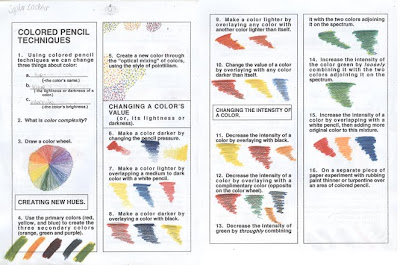by Basti Sayid
by Sophie Lackner
 Art I classes are finishing up colored pencil drawings. Students completed graphic organizers demonstrating their understanding of colored pencil techniques. These exercises are from The Colored Pencil: Key Concepts for Handling the Medium (Borgeson, 1983). We are learning that artists can change three things about a color: hue (a color's name), value (the lightness or darkness of a color) and intensity (purity or brightness of a color).
Art I classes are finishing up colored pencil drawings. Students completed graphic organizers demonstrating their understanding of colored pencil techniques. These exercises are from The Colored Pencil: Key Concepts for Handling the Medium (Borgeson, 1983). We are learning that artists can change three things about a color: hue (a color's name), value (the lightness or darkness of a color) and intensity (purity or brightness of a color). by Meghan Kelley
For these projects, by the Art I class, we are learning about colored pencil techniques and the Principle of Emphasis. Most works of art have a focal point (a main object or center of interest). We looked at several examples of works of art and how artists can emphasize the main object.
Seven Methods of Leading the Eye to the Center of Interest.
1. Isolation.
One way is to draw attention to the main object is simple: don't draw anything else. This is called Isolation and is the approach used in the portrait of Wolverine above.
 Stepping Out
Stepping Outby Danielle Cole
2. Subordination of Accessories. Accessories are what we call the other objects in the composition, other than the main object. We have to depict these in a way that lets the viewer know they are less important. We can do this by making them smaller, or vague, indefinite or sketchy. They should add their contriubtion to the scene but not distract from the main object.
 Rainbow Bouquet
Rainbow Bouquetby Basti Sayid
3. Organization of Accessories.
4. Arrangement of Line. This is using the prominent lines to lead the eye to the real subject.
5. Adjustment of Values. If the background is dark, the main object may be light in order to emphasize the focal point.
6. Placement. Where we put the main object can make it more noticeable. Often artists place it in the center or slightly off-center.
7. Color Scheme. If the main object is composed of bright warm colors, then the background may be primarily cool colors or neutral colors.
by Teddy Green
by Arianha Crawford
by Samantha Kitchin
For more about the Principle of Emphasis, see Pleasure from Pictures by Henry Turner Bailey (1926).






I still think that Sophie's Lightning Strikes speaks VOLUMES! Boy, what we could interpret from this. Ms. JAM
ReplyDeleteHi!
ReplyDeleteMy name ist Kathrin and I'm from Austria. I absolutely like you gallery :) Regards to all the artists!
Best wishes from Austria,
Kathrin